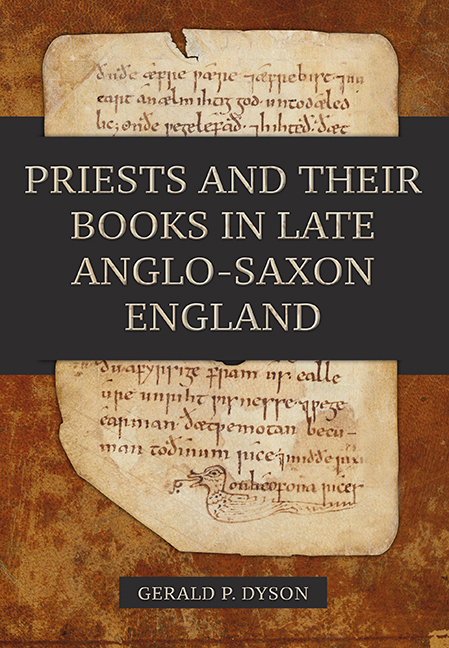Book contents
- Frontmatter
- Dedication
- Contents
- List of Illustrations
- Acknowledgements
- Introduction
- 1 Priests, Books, and Pastoral Care
- 2 “Ne cunnon þæt leden understandan”: Issues of Clerical Literacy
- 3 Demand and Supply: Production and Provision of Books for Priests
- 4 Preaching and Homiletic Books for Priests
- 5 Performing the Liturgy: Priests’ Books for the Mass and Office
- 6 Locating Penitentials, Manuals, and Computi
- Conclusions
- Appendix
- Bibliography
- Index
- Anglo-Saxon Studies
- Frontmatter
- Dedication
- Contents
- List of Illustrations
- Acknowledgements
- Introduction
- 1 Priests, Books, and Pastoral Care
- 2 “Ne cunnon þæt leden understandan”: Issues of Clerical Literacy
- 3 Demand and Supply: Production and Provision of Books for Priests
- 4 Preaching and Homiletic Books for Priests
- 5 Performing the Liturgy: Priests’ Books for the Mass and Office
- 6 Locating Penitentials, Manuals, and Computi
- Conclusions
- Appendix
- Bibliography
- Index
- Anglo-Saxon Studies
Summary
Christianity has long been recognized as a religion of the book. Within two or three decades of the death and resurrection of Jesus, accounts of his life were written and circulated, as were pastoral letters to newly founded churches in Europe and Asia Minor. Sources such as the pre-Pauline creed in 1 Corinthians 15 and the description of early Christian worship found in Justin Martyr's First Apology attest to frequent use of written liturgy and the texts that eventually formed the biblical canon, both of which are indicative of a strong literate element in these formative centuries. This element was passed on to the medieval church and has persisted to the present day. The dependence of Christianity on written texts necessitates literacy and the availability of books to those who lead its adherents – a need witnessed in the present day by the years of training that ministers undergo prior to ordination and the significant number of publishers whose business depends on the sale of bibles, commentaries, devotional volumes, and books for the liturgy.
Though the advent of printing and the rise of Protestantism stand between us and the books used by the medieval priest in England, the clergy's reliance on books has remained constant. Throughout the Middle Ages, the provision of the rites and services of the church by priests was largely reliant on access to certain texts, such as penitentials, books for the celebration of the mass and Divine Office, books of sermons or homilies, and others. These are frequently one of the very few routes we have into understanding the ministry of the secular clergy to medieval Christians outside of prescriptive sources and thus the study of priests’ books is an essential component in understanding the contexts for and practice of pastoral care. Scholarly interest in the study of pastoral care on its own merit has grown in recent decades, but has largely been limited to studies of individual aspects of pastoral care, a specific text, or a single priestly book, and it is my hope that this work will be a constructive addition to an important stage of development in this burgeoning field.
- Type
- Chapter
- Information
- Priests and their Books in Late Anglo-Saxon England , pp. 1 - 16Publisher: Boydell & BrewerPrint publication year: 2019

